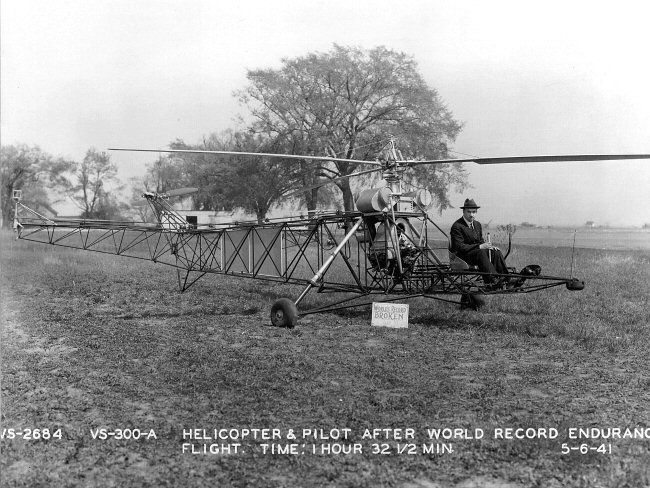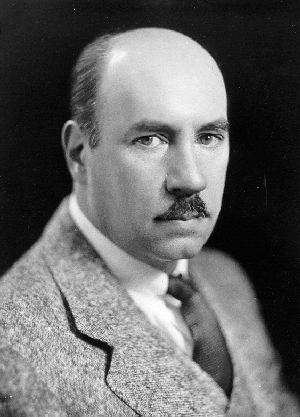
 6 May 1941: At Stratford, Connecticut, Igor Sikorsky piloted his Vought-Sikorsky VS-300 helicopter to a new world’s record for endurance. He flew for 1 hour, 32 minutes, 26 seconds. ¹ The previous record—1 hour, 20 minutes, 49 seconds—had been set by Ewald Rohlfs with the Focke-Wulf Fw 61 tandem-rotor helicopter, 25 June 1937. ²
6 May 1941: At Stratford, Connecticut, Igor Sikorsky piloted his Vought-Sikorsky VS-300 helicopter to a new world’s record for endurance. He flew for 1 hour, 32 minutes, 26 seconds. ¹ The previous record—1 hour, 20 minutes, 49 seconds—had been set by Ewald Rohlfs with the Focke-Wulf Fw 61 tandem-rotor helicopter, 25 June 1937. ²
During its development, the VS-300 went through at least 18 changes in its rotor configuration. This photograph, taken after the record-setting flight, shows an intermediate version, with one main rotor for lift and three auxiliary rotors for anti-torque and directional control.

In the final configuration, Sikorsky arrived at what we now recognize as a helicopter, with the main rotor providing lift, thrust and roll control through variable collective and cyclic pitch, and a single tail rotor for anti-torque and yaw control.
The VS-300 had a welded tubular steel airframe and used a 28-foot (5.34 meters) diameter, fully-articulated, three-bladed main rotor, which turned clockwise (as seen from above) at 260 r.p.m. (The advancing blade was on the left. This would later be reversed.) The main rotor had collective pitch control for vertical control, but cyclic pitch (Sikorsky referred to this as “sectional control”) for directional control would not be developed for another several months.
The tail “propellers” (what we now consider to be rotors—one vertical and two horizontal) each had two blades with a diameter of 7 feet, 8 inches (2.337 meters) and turned approximately 1,300 r.p.m. The vertical rotor provided “torque compensation” (anti-torque) and the blade pitch was fully reversible. The horizontal rotors were mounted on 10-foot (3.048 meters) outriggers at the aft end of the fuselage. For lateral control, the pitch on one rotor was increased and the other decreased. For longitudinal control, the pitch of both rotors was increased or decreased together.
 The VS-300 was originally equipped with an air-cooled, normally-aspirated 144.489-cubic-inch-displacement (2.368 liter) Lycoming O-145C-3 four-cylinder horizontally-opposed engine which was rated at 75 horsepower at 3,100 r.p.m. According to Mr. Sikorsky, “early in 1941,” the Lycoming engine was replaced by an air-cooled, normally-aspirated 198.608 cubic inch (3.255 liter) Franklin 4AC-199-E, a four-cylinder horizontally-opposed overhead valve (OHV) direct-drive engine with a compression ratio of 7:1, rated at 90 horsepower at 2,500 r.p.m. It is not known if this change was made prior to 6 May.
The VS-300 was originally equipped with an air-cooled, normally-aspirated 144.489-cubic-inch-displacement (2.368 liter) Lycoming O-145C-3 four-cylinder horizontally-opposed engine which was rated at 75 horsepower at 3,100 r.p.m. According to Mr. Sikorsky, “early in 1941,” the Lycoming engine was replaced by an air-cooled, normally-aspirated 198.608 cubic inch (3.255 liter) Franklin 4AC-199-E, a four-cylinder horizontally-opposed overhead valve (OHV) direct-drive engine with a compression ratio of 7:1, rated at 90 horsepower at 2,500 r.p.m. It is not known if this change was made prior to 6 May.
¹ During World War II, only a very few ballooning and gliding world records were certified by the Fédération Aéronautique Internationale. Although Sikorsky’s flight duration exceeded that of Rohlfs, it is not listed as an official world record.
² FAI Record File Number 13147
© 2019, Bryan R. Swopes